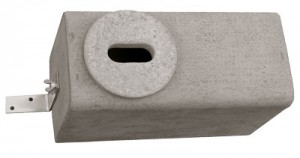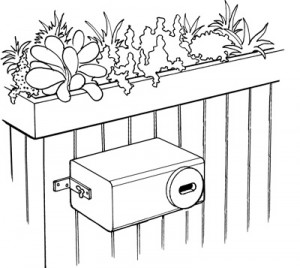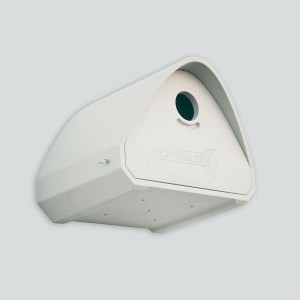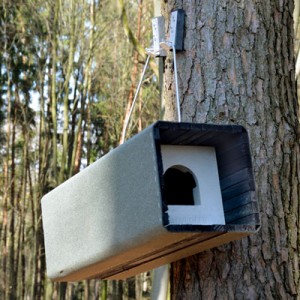General information on Swifts (Apus apus)
Swifts are uniquely adapted to life on the wing. They are mainly known and popular when a large number of them fly through our towns and cities on a warm summer evening, hunting for flying insects. During the summer months Swifts spend just four months in Europe, where they can be found all over the continent. They normally breed up to around 1,000 m above sea level. Winters are always spent south of the Sahara, for example, at the “Cape of Good Hope” in South Africa. Once they have been accepted, breeding sites are used by the same pair for many years, which means that removal of these roosts constitutes a serious threat to the Birds, as their familiar breeding site is missing on their return. Swifts are very social animals, so that colonies can form with any number of Birds. It is therefore advantageous if several nesting aids are installed. In principle a Swift pair occupies a nesting aid for one annual brood.
The survival of the Swift in our towns and cities is now under threat. This Bird species occupies niches and voices on all kinds of buildings. These places are often destroyed, blocked or at least made uninhabitable by building renovations or new buildings. SCHWEGLER replacement roosts can be used to create a very successful remedy. You can paint our nest boxes at any time with breathable paint to match the colour of the building façade. Please ensure that you only use paint that is “breathable”.
Swift Nest Box Series, Type No. 17
Our tried and tested Swift Boxes have been used successfully throughout Europe for decades. The lightweight boxes are especially suitable for retrofitting on external façades. Alternatively, they can also be installed directly in a façade.
Material: Certified, asbestos-free, vegetable fibre-reinforced concrete and SCHWEGLER wood-concrete. Galvanised fixing elements.
Installation: The entrance should be a minimum height of 6 to 7 m above the ground or protruding parts of buildings. Greater heights are possible at any time. Attaching the box directly under the roof edge is advantageous. It is very important to ensure that there are no protruding parts, roof parts, pipes, etc. below the entrance, as Swifts approach and fly away very steeply. Therefore, the area under the entrance should be unobstructed and lead directly to the ground. It is advantageous and we expressly recommend that several nesting aids be installed for the formation of Swift colonies. Swifts do not need a minimum distance from fellow species – nesting boxes can therefore be positioned directly next to each other.
Suitable positions: On external façades or under the roofs of all kinds of buildings, for example, houses, industrial buildings, churches, road structures, walls or even cliffs and rock faces. For outdoor installation in very sunny locations we recommend our wood-concrete Swift nesting aid as an alternative, e.g. No. 16. Alternatively, the boxes can also be bricked in or installed in the thermal insulation.
Cleaning and inspection: The Type 17 boxes can be cleaned after the entrance rose has been removed. To this end, the entrance is turned through 90° (entrance hole vertical) and is removed. But in general it is not necessary to clean the boxes if they are used by Swifts. The Swift nest is always made in the darkest corner of the roost and away from the entrance hole.
Colour matching: Type 17 nesting aids are supplied in natural grey. They can be matched to the background colour by painting them with breathable paint.
Versions without removable rose: On request we can also supply you with these boxes without a cleaning opening, i.e. with an elongated 30 x 70 mm hole only. Please ask if required. Optionally, the Swift Boxes can be ordered with entrance for Sparrows or entrance openings for rock shelter occupants.
Swift Nest Box No. 17B
single cavity, with enlarged brood chamber
This box provides a good compromise between weight, size and enlarged brood chamber. The larger brood chamber depth ensures more movement space is available, e.g. for training flying muscles. Easy to install with the two mounting brackets and fixing materials supplied as for Type No. 17A.
External dimensions: W 34 x H 15 x D 21 cm plus wing screws.
Brood chamber: W 30 x H 14 x D 20 cm.
Weight: approx. 4.8 kg.
Includes: Nest box, fixing bracket, screws, plugs.
 English
English Deutsch
Deutsch 







